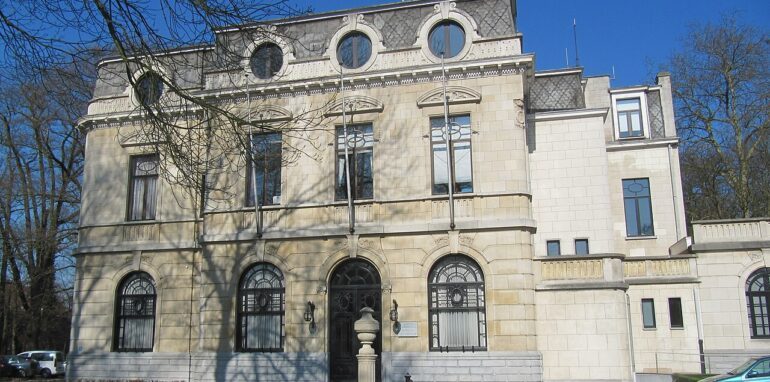To clarify the vast domain of the commons, and the many discourses and histories that intersect within it, it would be best, at least didactically, to distinguish between four types of conceptions of the commons. Let me do so here as briefly and clearly as possible.[1]
First, a brief situational note. Since about the turn of the century (or the millennium turn) there has been a new focus on the idea of “commons,” usually with direct reference to the English term “commons” (such as Clapham Common). This new movement constituted a resistance to the neoliberal “enclosures,” the wave of privatizations since the 1980s. It was certainly also a reaction to the ecological catastrophe as a threat to our greatest commons, the biosphere. And, finally, it was also very concretely a reaction to the 2008 crisis, where in Spain and Greece, for example, self-organization was a solution to acute poverty, with collective soup kitchens and squats.[2] But to really understand this concrete historical ‘wave’ you have to try to grasp the commons historically and theoretically (I try to hint at the historical in the sequence of my four approaches to the commons).
The philosophical common
First, there is the philosophical “commons,” which is at once the most obvious and the most confusing. Because the confusion already begins in language itself: common, commune, communication, communion, etc. It is so all-encompassing and so basic that it becomes elusive. But it is always about sharing and communicating. About mutuality. The common is what we have in common.
For example, great example, language itself. It is not owned or even under the care of the state, nor is it private (as Wittgenstein noted, there is no such thing as private language, which is a contradiction in terms). Language is shared or is not. And even dictionaries, grammarians, and even high societies such as the Académie Française can only follow what the street bakes of language year after year. This leads immediately to a first observation, even almost a definition: common is that which is neither public nor private, but common (managed or unmanaged, that’s what it will come down to, but let me not anticipate).
Language is our most inherent common. In more spatial or material terms, I like to give the example of air (no language without air, by the way). Air, like language, is not public, is neither state property nor private, but shared, and fortunately because after a long minute without air we would all suffocate. That one can buy and sell air rights or better pollution of the air rights is extremely problematic in that respect, but it is peculiar to neoliberal or capitalist logic to commodify everything, even the basic common.
A third textbook example for me is the oceans. They too belong neither to the state nor are they privately owned. This has consequences, because overfishing occurs partly because there is no one in charge of the oceans, so the oceans are an unguarded commons. There are international treaties, but well … who is going to enforce them? And now the multinationals want to mine the manganese nodules in the deepest depths of the oceans with possible catastrophic consequences for those still very unknown ecosystems. Fortunately, then, they cannot privatize the oceans as yet. Although concessions and thus privatizations are possible. Only international treaties that are enforceable can save the oceans. From the air and oceans to the biosphere as a whole is a small leap. The biosphere is our shared habitat, our greatest commons, shared with all living things (although the moon and Mars are also commons in a sense, but shared with all extraterrestrials, if they exist).
Language, air, the oceans, the biosphere: the commons are very large, almost all-encompassing. We who (especially among architects) are used to dividing the world into private or public, and if that fails, speak of semipublic or semiprivate – should recognize that the excluded, the forgotten third is by far the largest. But the common, the common lands, the tradition of subsistence based on the sharing of subsistence resources (lands, forests, fishing grounds, irrigation systems) was erased during the rise of capitalism, over centuries and several waves of enclosures (more on that later). And so it happened that the common as concept also disappeared from our collective imagination and from our worldview. Undoing this forgetting is a didactic, activist and at the same time philosophical task in itself.
In any case: the commons are all-encompassing, or at least there are all-encompassing commons, one usually calls them the global commons (in English), but I also like to call them universal, one could also call them transcendental (as in “language is transcendental”). The global, worldwide commons are much larger than the realm of the public and the private, but they are also unmanaged, unprotected, or at least under-protected, and therefore at risk. The focus on the commons has been prompted by these urgencies: the climate, a giant common, the biosphere itself, the web of life, is at risk. So much for an initial philosophical conception of the universal commons.
The legal commons
Then there is, very important and often forgotten, the legal commons. For this we must go back to the Magna Carta of 1225 and the Charter of the forest[3] : the people, the commoners, not only had common lands around their villages but also had the right to gather wood in the king’s forest, extremely important for heating, cooking, sweeping, roofs, etc. They also had the right to pick apples, mushrooms, they were allowed to fish in lakes and rivers, etc., all these things were allowed by law. One even had the right to graze one’s pig in the king’s forest. Only two things were forbidden: cutting down trees and hunting game, like deer. The latter was a privilege for the nobility. What is important here is that the common is not managed by the “commoners,” but is simply legislated. As were the commons in the traditional primal sense of common lands, but those common lands were indeed managed in common. The forests were simply available, and the charter of the forest determined what was allowed and not allowed.
It is these legal frameworks around forests and common lands that are swept away at the beginning of the sixteenth by the first wave of so-called “enclosures,” the closing off of common lands for large-scale sheep farming (to supply the Flemish wool industry). Thomas Morus writes his famous book Utopia, published in 1515 in Louvain, against this double crime, of dispossessing of land (often manu militari or by forced sale), which were also literally subsistence lands, destroying entire villages in the process (you have to think of it as a kind of economic cleansing, like an ethnic cleansing), and second criminalizing vagrancy and punishing theft with the death penalty. So first taking away people’s livelihoods, and then punishing them mercilessly if they wander around and let alone steal. It is this double shocking injustice that is denounced in the first book of Utopia with the conclusion that it is private property that is the cause of all evil. Book two then paints the dream of an island without private property. (Boring as a mixed monastery, unfortunately).
The legal commons disappeared with the enclosures, privatizations and also the nationalization of forests and common lands. That process lasted into the 19de century. But now they are all gone, so they have also disappeared from our imagination and from our worldview. Yet the legal commons have a great future, for example for the legal protection of the air or the oceans. Think of the Paris climate accords.
The economic commons
Then third, the most well-known form of the commons, the economic commons, which usually takes the form of a cooperative managing a particular resource in common. Nobel Laureate Elinor Ostrom, studied these economic commons, cooperatives, in different continents and over different centuries, with fishing grounds, alpine pastures and irrigation systems as prime examples, and with three basic elements: a community, a shared resource (common pool resource, in her terms) and a set of rules to manage and maintain that CPR.[4]
But these age old classic examples are not the end of it: also Wikipedia, for example, makes for a formidable example of a digital commons. For Wikipedia is neither public nor private, but created and managed and used by the many nerds behind their screens who collect and share knowledge for free for the good of the commons. So form whom it shimmers at philosophical juggling of abstractions about the commons, think of cooperatives, non-profit organizations, urban farming, squats and a thousand and one forms of self organized urban activism, but as said also Wikipedia and open sources platforms. So the ‘economy’ of a common can be without money and without even material exchange, just the organization and collection of knowledge.
We call these forms of commons the local commons or particular commons, versus the global and universal commons. Many commons today are forms of cooperatives (often asbl as a legal form). Under the abattoirs of Anderlecht in Brussels they grow mushrooms on coffee grounds collected from the cafes and restaurants in the neighborhood. There are many economic commons, at the same time they remain marginal in the face of the market and the state. That is the Achilles’ heel of the economic commons: their small scale.
The political conception of the commons
Along with Negri and Hardt, Dardot and Laval in their thick book, resolutely chop the end s of the commons: COMMUN.[5] Going back to the idea of mutuality, reciprocity in Proudhon and the anarcho-communist tradition, they rightly insist on the linguistic primal form of the co-munus, KO-MOINE in PIE (Proto-Indo-European): mutual duty as the basic form of the common. It is not the lands that are common, but the gesture of self-management and self-organization that underlies all that deserves the name of common(s). Hence their opposition to naturalizing the commons, as if there are things that are naturally more suitable for sharing.
For Dardot and Laval, the common is a praxis, a political practice of founding the common, of instituting, establishing based on reciprocity. It is important not to forget that this reciprocity is the ground of our welfare state, that it is the industrial workers who invented health insurance on the basis of mutuality: if we all pay reciprocally, then we have a treasury that will be called upon in case of illness. That mutualism was also the basis of unemployment benefits and pensions. To this day in Belgium, unemployment benefits are paid by the unions. (It is no accident that the new coalition proposal wants to abolish that.) It is very important to continue to remember and honor that tradition of self-organization and mutuality, and even more important to defend those achievements. That the welfare state has taken over much of that mutualism does not matter. On the contrary: like public transportation is better than “communal” transportation. The state is good at organizing public services for use by the common people, the commoners.
You can start to specify the political principle of the commons, besides self-organization and reciprocity, there is horizontality, very important. Direct democracy, decisions by consensus can also come into the picture when you try to shape the political idea of commons. The indignado and occupy movements have developed a whole vocabulary of gestures to facilitate group discussions in this sense. But the spirit of self-organization and horizontality is more important than those concrete gestures. Deciding by majority, for example, can prove more efficient than always striving for consensus.
In short, for Laval and Dardot, it is this reciprocity and therefore the co-munus of commoning, the mutual duty towards the community, that is the political principle par excellence. And who will prove them wrong? (Whether the dreams of the communism of capital through the self-organizing power of the multitude of creative producers dreamed of by Virno and Negri could ever become reality, however, remains doubtful.)
Conclusion
So all the confusion and muddle around the commons, all the oh and ah, all the mystery, at least all the ambiguity is thus, I hope, resolved once and for all. There are four main perspectives on the commons, four different concepts almost or forms of the commons: the philosophical, the legal, the economic and last but not least the political common.
These four views or concepts of the commons are not separate or at least there are many connections: the rediscovery of the common, is precisely about connecting the local, private commons with the global, universal commons: think global act local, means: people work to save the biosphere by doing urban agriculture with short chains or buying from cooperatives that do that. So that connects transcendental, universal commons and concrete, particular commons, or the philosophical commons and economic commons.
The same goes for the forgotten legal commons of the Charter of the forest: what we desperately need is a charter of the biosphere. The so-called Paris Accords should be or should have been a step in that protection of the biosphere, but, unlike the charter of the forest, they are hardly enforceable. At the end of the Magna Carta, it says in black and white that the commoners have the right to rebel if the king does not abide by the pact that was the Magna Carta. That’s what Extinction Rebellion and all the other radical climate activists and the climate justice cases want to do.
There are often overlaps between types of commons. A squat is simultaneously an economic commons and a political common: making a shared home and/or cultural centre based on appropriation of vacancy and self-organization. The political concept of the common without s, le commun, could come end neoliberalism if mutuality were understood again as the basis of living together, of the polis as such. Then the legal and economic commons would flourish as never before and the philosophical commons would be better than ever understood and protected as the most precious thing there is: life on earth and the wealth of symbioses and biomes on the planet.
Note: this is just a didactic diagram, maybe there are five or seven concepts of the commons. Maybe I have forgotten the poetic commons, or cultural commons, but in my opinion that parts of culture and poetry belong to the philosophical commons, as with language. I certainly would not be against treating a cultural commons separately, because then economics, politics and culture, what I called elsewhere the three spheres, are represented. Now, all didactic diagrams are there only to create clarity, in reality everything is intermingled.
For example, most of today’s “Urban commons” are hybrids, partnerships between urban government (which subsidizes), a cooperative and often private initiatives participating, in a organic food market for example. So the three bodies: state, private and common ideally work together (dialectically). Bottom up and top down ideally form a dialectic of critical understanding and cooperation with an open mind. Anyone who bets on one of the three to the detriment of the other two will end up in either a totalitarian state or an all-powerful market or an anarchist dream world. That does not prevent the economic, political and legal commons, all those practices of mutualization, from being much needed to save the biosphere, the web of life, as a global, universal, transcendental and therefore philosophical commons.
[1] There is one text on the mean, on the commons that I have not written. It should, however, have closed the cycle of my series of texts on that theme (see Lieven De Cauter, Ending the Anthropocene. Essays on Activism in the Age of Collapse, NAI010 publishers, Rotterdam, 2021. That is a pity. Because it had finally become clear to me, through teaching so many years about it, that there were four kinds of commons to be distinguished. I took advantage of the invitation to kick off the academic year in celebration at a venerable French National School of Architecture, to finally do my homework (Opening colloquium academic year, Sept. 12, 2024 at ENSASE, Ecole Nationale d’Architecture Saint-Etienne).
[2] A good introduction to the commons and its rediscovery is David Bollier, Think like a commoner, https://www.thinklikeacommoner.com/) The work of Stavros Stavrides and Massimo de Angelis looks at the commons more from an urban theory/architectural angle.
[3] On this, see Peter Linebaugh, the Magna Carta Manifesto, University of California Press, Berkely, Los Angeles, London, 2008.
[4] Elinor Ostrom, Governing the Commons, the evolution of Institutions for Collective Action, Cambridge University Press, 1990.
[5] Antonio Negri & Michael Hardt, Commonwealth, Harvard University Press, 2009; Pierre Dardot & Christian Laval, Commun, Essai sur la revolution au XXI siècle, Editions de la découverte, 2014.


















